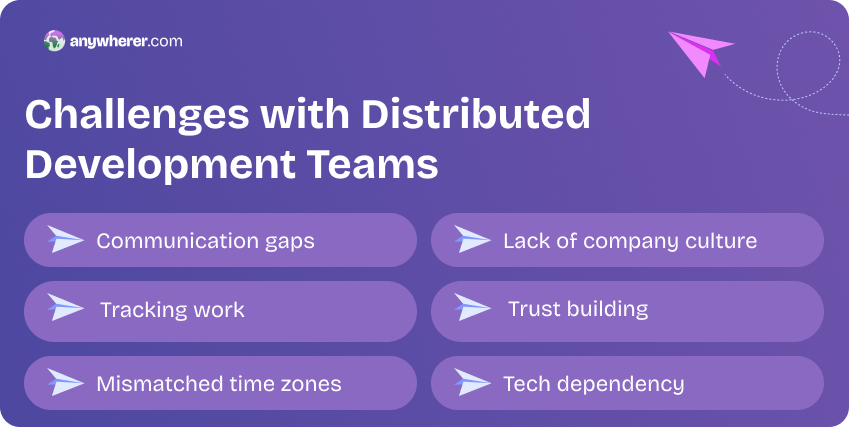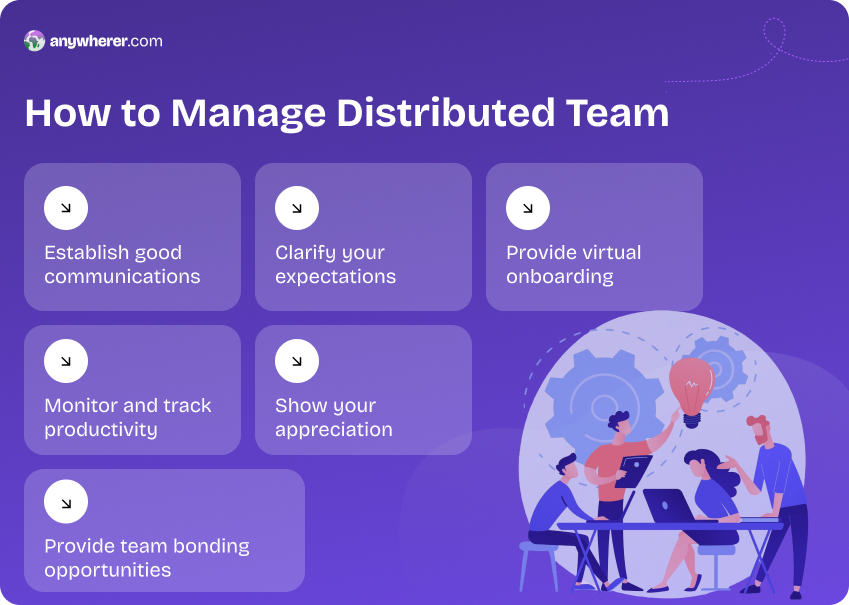What Is a Distributed Team and Why Does It Matter?
A distributed software development team is one in which team members have no central office and work remotely from different locations. Team members can be in a different city, state or country and may perform their online IT work from home, a rented office or public space. Running an agile software development with distributed teams is possible with the use of tools like project management platforms, source code databases, and messaging and videoconferencing software.
Distributed software teams matter because they are beneficial to both companies and employees. Some of the advantages for a business working with a global distributed remote team include:
- Cost reduction: employers can save approximately $11,000 per remote worker annually by reducing expenses on office space and related overheads.
- Access to a larger talent pool: remote work enables companies to recruit skilled professionals globally, enhancing diversity and innovation.
- Increased productivity: remote employees often report higher productivity levels, with 70% finding it easier to focus and 65% experiencing better stress management.
- Improved retention rates: organizations that support remote work experience 25% lower employee turnover compared to those that don’t.
- Enhanced employee satisfaction: remote work contributes to better work-life balance, with 71% of remote workers reporting improved personal and professional life integration.
There are a lot of benefits to the model as long as you manage distributed team members effectively.
Software Companies Thriving Using Distributed Teams
Software development companies have been working with distributed engineering teams for several years even before the pandemic. More than one company has demonstrated the possibilities when working with a globally distributed team effectively and efficiently. The following are some well-known companies leading distributed software development teams with great success.
Doist
Doist is the company that developed the popular Todoist app. They use a distributed team model that has 68 people working in 25 different countries and their success demonstrates how well this model works even without physical interaction between team members.
Slack
Slack is a multibillion-dollar company that uses outsourced distributed teams to develop its products. Interestingly, Slack is now one of the most popular communication tools for Agile software development with distributed teams and has millions of daily active users. Over 1600 Slack employees are outsourced and work remotely.
Buffer
Buffer provides a platform for social media management with over 300,000 active users. They started in 2013 with 8 team members and in the ensuing years have grown to 100 employees working remotely worldwide. The company believes that distributed development leads to better productivity.
Automattic
This is another company that has experienced great success using remote distributed teams. Automattic is responsible for WordPress and Tumblr along with a variety of other projects. There are currently almost 1,700 employees with the company distributed in 77 countries. Automattic has long been a proponent of remote working and the distributed team model.
Gitlab
Gitlab is a code collaboration platform that can be used for developing, reviewing and deploying software. They now have an estimated 30 million registered users including brands like Siemens and Sony. The original founders, Sytse Sijbrandij and Dmitriy Zaporozhets lived in different countries so Gitlab has been using a distributed work model from the start. The company’s workforce is now made up of over 1,400 employees from around the world. Gitlab is valued at well over $10 billion and began trading on the NASDAQ Global Select Market in October of 2021.
InVision
InVision, a digital product design platform, operates as a fully remote company with employees distributed across more than 25 countries. By embracing a distributed team structure from the start, InVision has built a culture centered on asynchronous collaboration, clear documentation, and intentional communication. Tools like their own product, along with Zoom and Slack, help them maintain team alignment and creativity despite physical distance. Their remote model has allowed them to attract top design and engineering talent globally, scale efficiently, and foster a flexible, employee-first work environment.
Common Challenges with Distributed Development Teams
The distributed team model has proven to be successful for many companies but it’s not without its problems.

Here are some of the common challenges in dealing with a globally distributed team.
- Communication. One of the biggest challenges for remote workers is distributed team communication. Communication is critical and a distributed agile team structure depends on effective collaboration and communication to be successful. Having Team members in different countries and time zones makes communicating far more difficult than when working in the same location. The agile development methodology stresses interaction so having the right communication channels and tools is critical when working with distributed agile teams.
- Tracking work. Software development projects will consist of a large number of tasks being performed by different team members. In many cases, some tasks must be completed before other parts of the project can move ahead. Keeping track of all the different tasks and deadlines can be extremely difficult when you don’t see your team in person. Monitoring and tracking all the different tasks and ensuring jobs are getting completed is another of the common distributed team challenges when you use remote developers.
- Mismatched time zones. A problem distributed team management often faces is having team members in multiple time zones. Getting a fast response from employees or scheduling team meetings can prove to be difficult when your regular working hours don’t match.
- Lack of company culture. Creating a unified company culture when you have a geographically distributed team can be a challenge. Remote employees may feel left out and excluded from the company culture due to lack of in-person interactions that are normal in traditional work environments. Although company culture can’t be quantified, it does affect productivity.
- Poor efficiency. The implementation and coordination of projects is a challenge when managing a distributed team. When your team isn’t working in the same location it can be hard to determine the cause of inefficiency but it can result in delays and interruptions to your project.
How to Manage Distributed Team and Transform It to High-Performing
Don’t be discouraged if you are unsure how to make distributed software development work. There are a variety of distributed teams best practices that if followed will help you overcome the challenges facing you. Here are 7 strategies and tactics for how to manage a distributed team successfully.

1. Establish good communications
As mentioned above, communication is one of the biggest issues when managing a distributed team. There are many different tools available to help you communicate with your team, and for team members to communicate with each other. Select the best tool to suit your needs. Other tips for communication in a distributed team include updating your team regularly in writing, scheduling regular meetings and taking time differences into account when scheduling meetings.
2. Clarify expectations
Managers of distributed teams should lay out clear guidelines and expectations for their team to avoid misunderstandings and problems that will cause disruptions in workflow and performance. The team needs to be informed about what tools will be used, the methods of communication, hours to be worked, project milestones and expected completion date. They should also be notified of any changes. It is a good idea for everything to be written down and made easily available to the entire team so each member knows what is expected of them.
3. Virtual onboarding
Provide an onboarding experience to help new team members get acclimated through video meetings. This will provide an opportunity for new members to start getting to know each other and feel connected to the team. Include onboarding documents with development standards, workflows and any details that will affect new hires. Videos and articles can be used to increase the onboarding process efficiency and you may consider assigning a mentor to new workers
4. Provide team bonding opportunities
With remote distributed teams in-person activities are usually not possible. Encourage social media pages and private chat groups for team members where they can interact on a more personal level. This can help in developing your company culture.
5. Monitor and track productivity
Establish KPI metrics for monitoring the progress of your team as well as individual team members. Productivity should be measured by what is accomplished rather than the hours spent doing a task. This enables you to monitor the progress of the project and get a handle on what each of your team members is capable of.
6. Employee recognition
Make sure to show team members that they are appreciated. A study by Bersin & Associates showed a 31% lower voluntary turnover rate at companies with good employee recognition programs. Recognizing employees for their achievements and showing your appreciation is how to retain talent in distributed teams and motivate employees
7. Select the right people
The success of a distributed team will ultimately depend on the people you hire. Of course, you will look for developers that have the skill sets you require but the best remote workers also have self-discipline and the ability to focus. Managers will need to look at a candidate’s soft and hard skills to determine if they are a good fit.
Best Ways to Find Potential Remote Dedicated Developers
Once you have decided to go with a distributed team model the next step is finding potential remote developers for your team. There are two main approaches to finding dedicated developers for your distributed team.
Freelancers
Freelance developers can be a good choice for smaller projects if you already have your processes in place. There are thousands of freelance developers willing to work remotely but you will need a good screening and evaluation process to ensure they have the skills and experience you require. You may want to start by looking through your personal circle of contacts as referrals from people you trust can be good but there are other options.
- Technical blogs and social networks: a good place to start your search is technical blogs and social networks. LinkedIn, StackOverflow, Hacker News and GitHub are all good sources.
- Freelance websites: there are plenty of freelance websites where you can find developers. Sites like TopTal, Upwork, Freelancer, Guru and AngelList are just a few of the sites that specialize in connecting freelancers with companies.
Outsourcing/Outstaffing Firms
Remote outsourcing companies are a good choice when you want to avoid a lot of the administrative duties that come with hiring a distributed team, when you have a tight schedule and when you need specialized or hard-to-find skills. Outsourcing vendors manage the recruitment process but the final decision on hires will be left up to you. They are generally flexible and you can hire a single specialist or an entire dedicated team for projects. Clutch, VenturePact and Goodfirms are some good sites you can use to help you find a software development outsourcing firm.
Regardless of the method, you use to find developers you will want to review the qualifications of candidates and conduct interviews with the potential new hires you prefer. You should know how to conduct a virtual interview with candidates and have a good list of questions for checking both hard and soft skills. It is at this point that you narrow down the list of candidates to your final choices for your distributed development team.
When managing a distributed team effectively, understanding different workforce management models is essential. The ASO model (Administrative Services Only) allows businesses to outsource HR functions while retaining control over their employees, whereas the BPO model (Business Process Outsourcing) helps companies delegate entire business functions to external providers. Choosing the right approach can streamline operations and enhance team efficiency.
Top 6 FAQs for Managing Distributed Teams
How can I improve communication in a distributed team?
Use collaboration tools like Slack or Microsoft Teams to keep communication centralized and accessible. Establish clear communication norms, such as response time expectations, preferred platforms for specific discussions, and regular team updates. Schedule weekly or bi-weekly check-ins to ensure alignment and address concerns proactively.
What’s the best way to manage time zone differences?
Identify overlapping work hours for key team members and schedule meetings or collaborative work during these times. Use shared calendars to help everyone stay informed of different time zones and upcoming deadlines. Additionally, record meetings for team members who cannot attend live sessions and provide asynchronous updates.
How do I ensure productivity in a distributed team?
Set clear, measurable goals and deadlines for each team member to ensure accountability. Utilize project management tools like Asana, Trello, or Monday.com to assign tasks, track progress, and manage workloads. Conduct regular performance reviews to address challenges, recognize achievements, and keep the team motivated.
How can I build trust in a remote team?
Encourage open and honest communication where team members feel comfortable sharing their thoughts and concerns. Recognize individual and team achievements through shout-outs or dedicated appreciation sessions. Organize virtual bonding activities, such as online games, coffee chats, or team-building exercises, to foster personal connections.
How do I handle cultural differences?
Promote inclusivity by creating an open space where team members can share their cultural backgrounds and perspectives. Encourage respect and sensitivity when discussing different customs or working styles. Provide training on cross-cultural communication if needed to improve understanding and collaboration.
What tools are essential for managing a distributed team?
Use Zoom or Google Meet for virtual meetings, Slack or Microsoft Teams for instant communication, and tools like Trello, ClickUp, or Jira for project management. Platforms like Google Workspace or Microsoft 365 ensure seamless document sharing and collaboration, while time-tracking tools like Toggl can help monitor productivity when necessary.
To streamline your development process and improve productivity, start implementing top management practices today and get your distributed team motivated!
Marharyta is a seasoned marketing expert with a rich background in supporting dedicated development teams and a keen understanding of the nuances of global remote employment solutions. With a solid track record of executing impactful campaigns, crafting strategic marketing plans, and delivering high-quality content, Marharyta plays a key role in establishing Anywherer as a reliable source in the EOR and international workforce management industry.





